
Bullet and Splinter Wound Care Page Menu: 1 2 3 4 5 6 7 8 9 10 Next>>
Bullet and Splinter Wound Care in the Golden Age of Piracy, Page 1
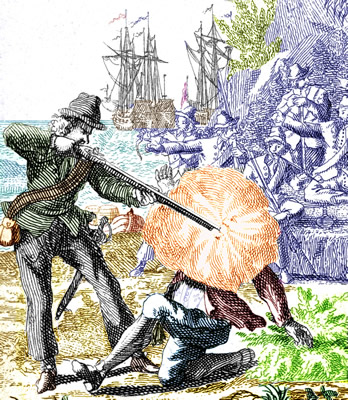
Edward Low Shooting Someone, From Histoire der Engelsche
Zee-Roovers (1725)
"Although I have noticed the general appearance of wounds from musket or pistol balls, yet these are not so dreadful in their effects, as those from cannon shot and splinters; which are by far the most common on board ships of war." (Edward Cutbush, Observations on the Means of Preserving the Health of Soldiers and Sailors, 1808, p. 235)
Bullets and Splinters were linked in the minds of surgeons during the golden age of piracy. While it may seem that this could be tied to their common source - cannon shot which produced the splinters was fired using gunpowder in the same manner as pistols and other arms - there was actually a more tenable link. Both wounds were produced by foreign objects entering the body and resulted in the same sort of wound: one that produced a broken skin wound combined with unbroken skin bruising around the edges which was characterized by discolored skin. As a result, much of the treatment method for bullet and splinter wounds was handled the same way by surgeons at this time.
This article looks at the both bullet and splinter wounds, beginning with examples of them contained in the period sea and pirate literature. Shipboard methods for preventing splinters created by cannons striking the wooden ships of the time are briefly discussed as well. The theories of treatment are then examined along with several incorrect theories of treatment which were mostly phased out just prior to this period.
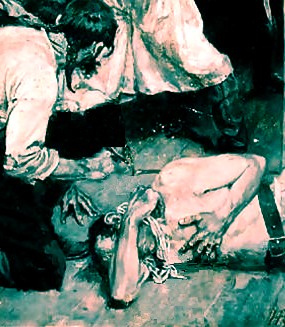
Artist: Howard Pyle
Treating a Wounded Man (1895)
From there the article examines the treatments used which were unique to gunshot and/or splinter wounds. Because they combined aspects of broken and unbroken skin wounds, these wounds were handled somewhat differently than either. However, they largely still fit into the framework established by several period authors for broken skin injuries. The steps of treatment for broken skin wounds include:
Step 1: Remove foreign objects.
Step 2: Bring the wound lips together.
Step 3: Keep the wound lips together.
Step 4: Maintain wound temperament.
Step 5: Remedy complications.
Since the essential information about how these steps were used on broken skin wounds is discussed in great detail in the article on simple wounds, that will not be discussed here. This article will instead explore the more unique facets of gunshot and splinter wounds as they fit within the above framework.
The first unique facet expands upon Step 1 as it relates to removing bullets and splinters. It also looks at the tools used for this. The second unique facet of these wounds concern the processes used to treat and dress gunshot and splinter wounds instead of bringing the wounds lips together with sutures and similar methods. (This will be referred to as Step 2F since it concerns Foreign objects and replaces the normal Steps 2 & 3 used in Simple Wound procedures.) The third unique facet of bullet and splinter wounds involves humor-based procedures which are a part of Step 4. The final unique facet concerns complications related to such wounds. So the surgical procedure for gunshot and large splinter wounds is:
Step 1: Remove foreign objects.
Step 2F: Keep bullet and splinter wounds open.
Step 4: Maintain wound temperament.
Step 5: Remedy complications.
Bullet Wounds at Sea - Sailors and Pirates
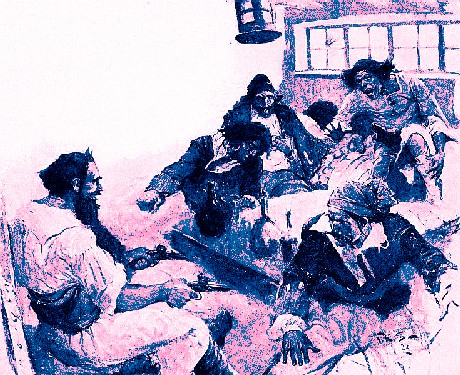
Artist: Frank E. Schoonover - Blackbeard Shoots Israel Hands (1922)
"One night, drinking with in his cabin with [Israel] Hands, the pilot, and another man, Black-beard, without any provocation, privately draws out a small pair of pistols, and cocks them under the table. While being perceived by the man, he withdrew and went upon deck, leaving Hands, the pilot, and the Captain together. When the pistols were ready, he blew out the candle and crossing his hands, discharged them at his company. Hands, the master, was shot through the knee and lamed for life; the other pistol did no execution. Being asked the meaning of this, he only answered them by damning them, That if he did not now and then kill one of them, they would forget who he was. " (Charles Johnson, A General History of the Robberies and Murders of the Most Notorious Pirates, 3rd edition, p. 56)
There are a variety of instances in the golden age of piracy era accounts of sailors and pirates being shot by pistols and muskets. (There are also a variety of accounts of pirates attempting to shoot only to have their weapon misfire - sometimes referred to as the pistol 'snapping' or 'being snapt'1.) The number of gunshot wounds should not be surprising given the reliance on these weapons during battles. Naval surgeon Hugh Ryder noted during a battle with two Turkish ships that they
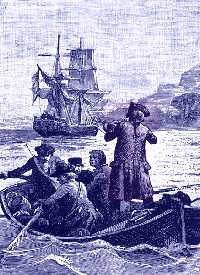
Artist: George Roux
Firing at a Ship (1885)
did so gaul us with their small Shot, that a Man could scarce appear upon the Deck, where several of our Company received very untoward Wounds, viz. one of our Men halling at a Tack to run out a Gun, was shot with a Musquet Bullet through both Arms, near the middle and hinder parts of the Brachia [upper arms]2
Because so many gunshot wounds from this period related to privateers and pirates were recorded, we can focus here on examples specific to these professions.
We begin with gunshot wounds received by Woodes Rogers three year privateering voyage against the Spanish which ended when they had circumnavigated the world. Rogers' records a number of gunshot wounds. During their attack on Guayaquil, Ecuador, several of their men were shot. Rogers notes that Dutchman Yerrick Derrickson "was shot thro’ between the lower Part of his Neck and Shoulder but I believe not mortal."3 The next day, William Davis "was shot through the hinder part of the Neck by the Enemy, the Wound not dangerous"4.
Two days later, a man was shot in the calf of his leg; he did not survive the wound as a result of "his Irregularity and hard drinking [from which cause he] fell into a Fever that carried him off."5 (While his personal habits probably didn't help, it was more likely infection from the wound that 'carried him off'.)
Not all their wounds in Guayaquil were a result of enemy fire. Rogers reports that a Lieutenant Stratton, "having his Pistols hanging at his Side, one of them unluckily discharg'd it self against the Outside

Artist: William Hogarth - Woodes Rogers (1726)
of the thickest part of his Leg, and left a Bullet in the Flesh, but there’s little Danger of his Life. He being by this Accident disabled to make a quick Retreat, it occasion requir’d, his Captain immediately order’d him on board the Bark."6 There were several surgeons in Rogers' crew during this voyage which no doubt helped immeasurably in the men's survival after receiving such wounds.
Perhaps the most interesting gunshot wound from Rogers' voyage was the one he himself suffered during the running fight with the Spanish ship Nuestra Señora de la Encarnación y Desengaño (Literally: Our Lady of the Incarnation and Disappointment). Although the ship was captured by Rogers men, he reports "I was shot thro' the Left Cheek, the Bullet struck away great part of my upper Jaw, and several of my Teeth, part of which dropt down upon the Deck, where I fell."7 As a result of this wound, speaking caused him so much pain that he had to write anything he wanted to say.
His later account of this wound is quite detailed; he reported that during the night two days after receiving the wound, "I felt something clog my Throat, which I swallow'd with much Pain, and suppose it's a part of my Jaw Bone, or the Shot"8. Part of his throat was swollen for nearly two months which not being relieved until "I got out a Piece of my Jaw Bone, that lodg'd there since I was wounded."9 Four months later, he wrote that
the Doctor cut a large Musket Shot out of my Mouth, which had been there near 6 Months, ever since I was first wounded; we reckon'd it a Piece of my Jaw-bone, the upper and lower Jaw being much broken, and almost closed together, so that the Doctor had much ado to come at the Shot to get it out. ...The Hole the shot made in my face is now scarce discernable.10
Another privateer who sailed to South American and around the world on his return was George Shelvocke. His voyage began more than ten years after Rogers' voyage in 1719, returning to England in 1722. Shelvocke published and account of the journey which mentions several instances of gunshot wounds. The first was in August of 1719 when a group of his men went ashore at Santa Caterina in Brazil (probably to steal from the locals) and
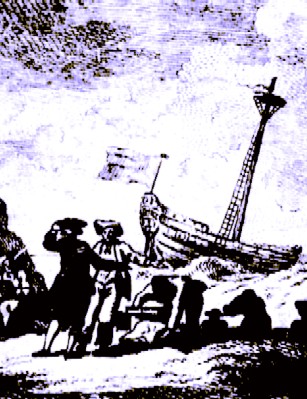
Sinking of the Ship Speedwell off Juan Fernandez, From A
Voyage Round the World, 2nd ed., By George Shelvocke (1757)
were attacked by the residents as they left. Shelvocke explains that the Portuguese fired "a volley of small arms, which wounded three of my men, two through the thigh, and another through the arm. …The wounded sustained a great loss of blood, by being so long before they got aboard, for they were above 3 leagues [about 11 miles] distant from the ship: but having an expert Surgeon, he performed the several cures with much greater success than cou'd have been hop'd for."11
Shelvocke's surgeon Nicholas Adams, assisted by his surgeon's mates William Morgan and John Doidge, does indeed seem to have been quite capable. When Shelvocke's ship was wrecked at Juan Fernandez Island in May, 1720, they spent the summer and early fall building a new vessel to escape. The left on October 6th, attacking the St. Malo-based ship Margarita on October 10th in an effort to get a better ship and provisions. During the skirmish, their gunner was killed and three other men, were "wounded which were Mr. Brooks, first Lieutenant, thorough the thigh, Mr. Coldsea, the Master, thorough the groin, and one of the fore-mast men in the small of his back"12. Brooks and the foremast man recovered "and I think there was some thing extraordinary in their cure; for the Surgeon had nothing to apply to their wounds, but what he had himself prepared with Seal's oyl, and other matters he had found on the Island [Juan Fernandez]."13 Coldsea, unfortunately, "linger'd in a miserable manner for 9 or 10 mouths after wards: but at length recover'd."14 Given the types of wounds, it is amazing that all three survived. The only other gunshot wound Shelvocke mentions is during the privateers' capture of the Spanish ship de Conception de Recova where "there was little or no hurt done, except to our Gunner who was slightly wounded in the forehead by a pistol-ball"15.
Several pirate accounts recorded gunshot wounds. Jean-Baptiste Labat records that while sailing with French filibuster Captain Daniel, they captured an English ship. "The English captain had been shot in the arm and our surgeon hastened to examine the wound, but found that it was not serious as it was only through the flesh. I made him lie down in [Captain] Daniel’s cabin"16. That was unusually good treatment for a prisoner taken by pirates.
-the_Mates_Body_Howard_Pyle_1895.jpg)
Artist: Howard Pyle (1895)
A variety of men were wounded by bullets during Captain Thomas Pound's fight at Tarpaulin Cove, Naushon Island in October of 1689. Thomas Johnston was shot in the jaw resulting in several bones being removed. David Lander was shot through one of his arms and John Siccadam was shot in both of his legs. Eleazer Buck "had seven holes shot through his arms" while Richard Griffen was "shot in the ear in the fight at Tarpaulin Cove, the bullet coming out through an eye which he lost"17. It was clearly not a very good day for the pirates in that fight, although they apparently had medical attention because all these men made it to trial.
One of Edward/Christopher Condent's men, only described as 'an Indian man' took revenge on the crew for beating him by going into the hold and threatening to blow their ship up. The men wanted to cut holes in the deck and lob grenades into the hold, "but Condent said, that was too tedious and dangerous since the fellow might fire through the deck and kill several of them. He, therefore, taking a pistol in one hand, and his cutlass in the other, leaped into the hold. The Indian discharged a piece at him, which broke his arm; but, however, he ran up and shot the Indian."18 Pretty brave stuff from the captain, although the result was a compound gunshot wound that no doubt resulted in some time with the ship's surgeon.
Pirate captain Thomas Howard's men got into an entanglement with Ort Van Tyle after they captured him and ransacked his house on Madagascar. He turned on them with his gun, shooting one pirate through the arm and thigh as well as shooting "the captain [Howard] through the arm, but he [Howard] got on board [his ship], where his arm was set."19
From the trial of Bartholomew Robert's men, we learn that pirate Thomas Sever was shot in the shoulder, and, as a result, "desir'd of Roberts for that reason that he would acquit him [from participating in the attack on the Navy ship]”20.
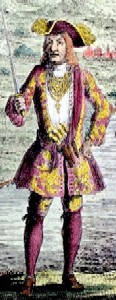
Bartholomew Roberts
(1724)
The last comment is a curious detail, given that most men who were wounded on ships with surgeons (of which Robert's crew had several) would be sent below deck to be dressed and thus were out of harm's way for the duration of the battle. However, Article 7 on Robert's ship stated that "To desert the ship or their quarters in battle, was punished with death or marooning."21 With this in mind, Sever may have felt it was best to ask permission for leaving the fight, even with a gunshot wound.
Wounds made by cannon were less frequently a matter for the surgeon, in part because they were less likely to occur and in part because when they did occur, they often resulted in the death of the man hit. Captain Johnson rather poetically explains that during his fight with Captain Chaloner Ogle of the HMS Swallow, Bartholomew Roberts would have "finished the Fight very desperateIy, if Death, who took a swift Passage in a GrapeShot, had not interposed, and struck him directly on the Throat."22 Grapeshot consists of small metal slugs packed tightly into a canvas bag which was fired from a cannon. Captain Ogle's men were either good shots or very lucky. During the same battle, John Walden's leg was shot off by enemy artillery fire.23
Edward Barlow was struck by a cannon ball during his service to the crown in the Second Dutch War, explaining that "an unlucky shot that come from the ‘Holens’ [a Dutch ship], coming through our ship’s side, hit me on the hollow of my ham on the right leg, it striking me lame for the present, but I praise the Lord it was spent before it hit me or else it would have carried my leg away, but it did me no great harm"24.
Most curiously of all, were reports that men were wounded by artillery that didn't even hit them. Surgeon Ambroise Paré explained that during a 1545 military campaign,
a peece of Ordinance... passed very neare one of them [two men on horseback], which threw them to the ground, and t'was thought the said Bullet had toucht him, which it did not at all, but onely the winde of the said Bullet in the midst of his coate, which went with such a force that all the outward part of the Thigh became blacke and blew25.
1 See for example, Charles Johnson, The History of the Pirates, 1829, p. 108 & 264, Phillip Ashton, Ashton's Memorial, 1726, p. 19, George Francis Dow and John Henry Edmonds, The Pirates of the New England Coast 1630-1730, p. 285, The Boston News-Letter, Thrusday February 4. to Thursday, February 11. 3 Woodes Rogers, A Cruising Voyage Round the World, 1712, p. 177; 4 Rogers, p. 178; 5,6 Rogers, p. 182; 7,8 Rogers, p. 294; 9 Rogers, p. 359; 10 Rogers, p. 390-1; 11 George Shelvocke, A Voyage Round the World by Way of the Great South Sea, 1726, p. 47-8; 12,13,14 Shelvocke, p. 265; 15 Shelvocke, p. 371; 16 Pere Jean-Baptiste Labat, The Memoirs of Pére Labat 1693-1705, p. 253; 17 Dow & Edmonds, p. 70-1;18 Johnson, History of the Pirates, p. 123; 19 Johnson, History of the Pirates, p. 150; 20 Pyrates Lately taken by Captain OGLE, 1723, p. 55; 21 Ed Fox, Piratical Schemes and Contracts (Doctoral Dissertation), p. 318; 22 Captain Charles Johnson, A general history of the pirates, 3rd Edition, p. 272; 23 Pyrates Lately taken by Captain OGLE, p. 30; 24 Edward Barlow, Barlow’s Journal of his Life at Sea in King’s Ships, East and West Indiamen & Other Merchantman From 1659 to 1703, p. 118-9; 25 Ambroise Paré, The Workes of that Famous Chirurgion Ambrose Parey, 1649, p. 770
Splinter Wound Examples
The biggest threat to the men from artillery fire does not seem to have been from direct hits, rather it appears to have been the splinters they generated. Multiple accounts of the danger of splinters can be found from this era.
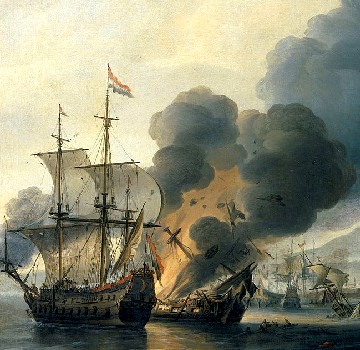
Artist: Willem van Diest - Battle of Leghorn (mid_17th c.)
Several examples of splinter wounds from this era come from surgeon's accounts.
Sea surgeon James Yonge records three splinter wounds that took place during a battle in Algiers in 1661. They included a lieutenant "wounded deeply on the buttocks with a splinter", a volunteer "Wm. Gregory had the upper part of his foot torn with a splinter" and a ship's boy who "had the calf of his leg torn by a splinter"1. Fellow sea surgeon John Atkins presented the treatment of a case where a sailor "received a Compound Fracture of his Right leg, by a Splinter in an Engagement with the Enemy"2.
Military surgeon Richard Wiseman who served several years at sea, discussed a case where a sailor "had his right Arm extreamly shattered about two Fingers breadth, on the outside above the Elbow, by a great Splinter."3 Wiseman had intended to cut the arm off, but was forced to quickly bandage the wound when the ship he was on collided with a fire-ship, setting their vessel alight. After the fire-ship was cut loose and the fire dealt with, Wiseman returned to his patient intending to cut the wounded arm off with a razor, "but the man would not suffer me to meddle with his Arm, he crying, it was already drest."4 So he was forced to treat the man's shattered arm.
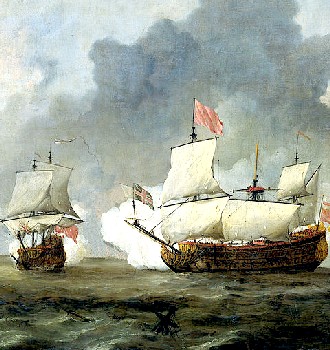
Artist: Willem van de Velde II - Battle of Solebay (1691)
Some other examples of men seriously wounded by splinters resulting from artillery come from pressed navy seaman's pension claims related to the Dutch Wars. Samuel Giles petitioned for a pension in 1674, detailing his wound as being received
by ye splinters of ye ship procured by cannot shott from ye enemie, had almost all his teeth strook out of his head and ye Joyntes & toes of his Left foot torne & dislocated whereby he is soe maimed that he hath ever since lost ye use of his foot and not bin able to worke at his trade being yet under ye hands of ye cherurgeon’s to his great greife Expence & damage.5
He was awarded a £2 per annum pension for his wounds.
Among the pensions awarded in Devon, England between 1660 and 1692 there were four awarded for men who were wounded by "Splinters from ship"6. While this only made up 7% of the total wounds pensioned during that period, it is still notable number.
The Second Dutch War seems to have been particularly bad for splinter wounds. In his Journal from 1666, Edward Barlow noted that he "had a small hurt with splinters of the ship the day before, but not much: but my leg swelling so that I could not go, I was forced to go down [into the lower deck of the ship] amongst the wounded men"7. Another battle in that war resulted in Sir Thomas Allin being "hit by wooden splinters in the face, elbow and arm and [as a result] was 'very ill'"8.
Not long after being shot in the face (which was discussed in the previous section), privateer captain Woodes Rogers was
unfortunately wounded in the Left Foot with a Splinter just before we blew up on the Quarter-deck so that I could not stand, but lay on my Back in a great deal of Misery part of my Heel-bone being struck out, and all under my Ankle cut above half thro', which bled very much, and weaken'd me, before it could be dressed and stopt.9
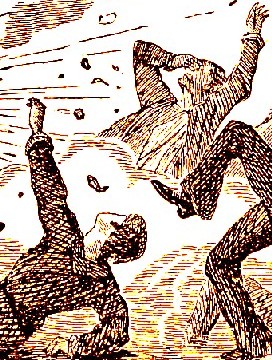
From Presidents, Soldiers, Statesmen, p. 73 (1889)
Like the bullet wound he received two days earlier, this wound took a long time to heal. Rogers recorded that he had had "several Pieces of my Foot and Heel-bone taken out, but God be thanked, am now [about six months after receiving the wound] in a fair way to have the Use of my Foot and recover my Health."10
Unlike gunshot wounds, there are few actual accounts of pirates being wounded by splinters. While it is tempting to suggest that pirates didn't suffer splinter wounds, the more likely explanation is that the period sources for the pirate's accounts didn't record the exact cause of the wounds they received. Most of the primary sources for the pirates come from newspapers and court trials, which were less interested in recording such details as the types of wounds received and more interested in recording the who, what, when, where and how of the events they were discussing. A variety of such reports simply note the number of men wounded and killed without giving specific information on how this occurred.
However, Jean-Baptiste Labat does mention a splinter wound during his time spent aboard French filibuster Captain Daniel's ship when they fought with an English vessel. During that battle he says, "We received a shot in our hull which made the splinters fly and wounded two of our men"11. So the pirates were definitely not immune to splinter wounds.
1 James Yonge, The Journal of James Yonge [1647-1721] Plymouth Surgeon, p. 42; 2 John Atkins, The Navy Surgeon, 1742, p. 69; 3 Richard Wiseman, Of Wounds, Severall Chirurgicall Treatises, 1676, p. 425; 4 Wiseman, p. 426; 5 Geoffrey L. Hudson, "The Relief of English Disabled Ex-Sailors, c. 1590-1680", The Social History of English Seamen, 1485-1649, p. 242; 6 Geoffrey L. Hudson, “Disabled Veterans and the State in Early Modern England”, Disabled Veterans in History, David A. Gerber, ed., 2015, p. 133; 7 Edward Barlow, Barlow’s Journal of his Life at Sea in King’s Ships, East and West Indiamen & Other Merchantman From 1659 to 1703, p. 119; 8 John J. Keevil, Medicine and the Navy 1200-1900: Volume II – 1640-1714, p. 95; 9 Woodes Rogers, A Cruising Voyage Round the World, 1712, p. 302; 10 Rogers, p. 391; 11 Pere Jean-Baptiste Labat, The Memoirs of Pére Labat 1693-1705, p. 252
Preventing Splinters
Writing in the mid-17th century, Nathaniel Boteler authored a book which presented the rules and customs of the Royal Navy. Among the information it contained were a variety
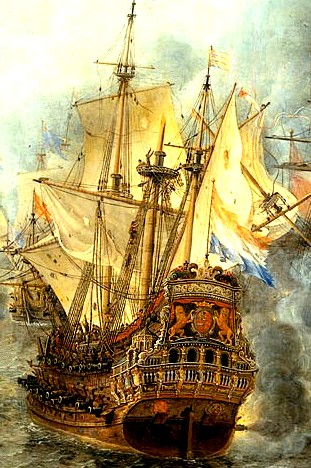
Artist: Jan Abrahamsz Beerstraten
Several Above Main
Deck Wood Structures (1653-1666)
of methods for preventing men from being wounded by flying splinters generated by ordnance. Boteler noted that although sailors liked having cabins on a ship, "yet are these cabins no better than nasty holes, which breed sickness, and in a fight are very dangerous, as causing much spoil with their splinters"1.
Boteler was definitely not a fan of cabins and wooden structures on or above the main deck of the ship. He later reiterates this point in explaining how to prepare for a fight. "Your own ship being aforehand made redy, by the taking down of all wainscot [oak plank] cabins; or at least with stuffing them with beds; sea-gowns, or the like stuff, whereby to dead[en] the enemy’s shot, and defend your men from their splinters"2.
Boteler's last suggestion concentrates on the best way to construct the ship so that splinters generated by cannon fire will be minimized:
As for the preservation of your men from the spoil of the enemy’s cannon, the best and surest course that I can apprehend, is by the fitting and strong stanchioning [inclusion of upright supports] of your midship’s part throughout, with two rows of the stanchions made of elm planks, or the like wood, that will not splinter; and these are to be of four of five inches in thickness; and to be set four or five feet in distance, the one row from the other; and the void place betwixt them is to be stuffed up with junks of cables, old ropes, sea-gowns, beds, or the like; and so be made cannon proof.3
In addition to recommending the use of padding in a ship to dampen the effect of splinter projectiles and proper construction of the interior of the vessel to this end, Boteler includes some interesting suggestions about type and thickness of wood which he says will be least likely to splinter.
Another, rather curious idea related to preventing splinters came from 
Artist: Martin Archer Shee - Sir Gilbert Blane (1833)
the experiences of the Physician to the Fleet from 1779-1783, Scottish doctor Gilbert Blane. His observations about the fleet's losses during battles being based on the distance and velocity of cannon balls striking ships contains the germ of an idea for reducing the number of splinters that occurred.
When ships in action are opposed to each other at a small distance, the velocity of cannon balls is so great, that in penetrating a ship's side, few or no splinters are torn off; and by these more men are commonly killed and wounded, than by the ball itself. For the same reason, a close shot does less damage also to the ship itself, than a distant one; for a quick-flying ball makes an aperture less than its own diameter, whereas a spent one produces innumerable deadly splinters, at the same time shivering [splintering] the object it strikes, and making wide and extensive rents in it. The proportion of the wounded to the killed, is also greater in distant than in close fight, on account of the great number of small splinters; and we have an experimental proof of this, in comparing the action in Fort Royal Bay in April 1781, with this near Dominica in April 1782. In the former, the enemy having kept far to windward, and engaged at a great distance, the proportion of the wounded to the killed was considerably more than four to one; whereas in the latter, where the greater part of the battle was close, the proportion of the wounded to the killed, was little more than three to one.4
Of course, it would be challenging in the best of battle situations to maintain a specific distance.
1 Nathaniel Boteler, Boteler's Dialogues, 1929, p. 257; 2 Boteler, p. 292; 3 Boteler, p. 304; 4 Sir Gilbert Blane, Observations on the diseases incident to seamen 1785, p. 98-9;

